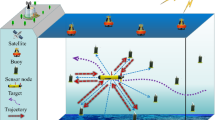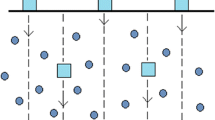Abstract
Today, underwater target tracking using underwater wireless sensor networks (UWSNs) is an essential part in many military and non-military applications. Most of moving target tracking studies in UWSNs are considered in two-dimensional space. However, most practical applications require to be implemented in three-dimensional space. In this paper an adaptive method based on Kalman filter for moving target tracking in three dimensional space using UWSNs is proposed. Since, energy protection is a vital task in UWSNs; the proposed method reduces the energy consumption of the entire network by a sleep/wake plan. In this plan only 60% of the closer nodes along the path of the moving target will be waked up using a sink activation message and participate in the tracking, while the other nodes remain in sleep state. At each stage of tracking, the location of the target is estimated using a 3D underwater target tracking algorithm with the trilateration method. Subsequently, the estimations and target tracking results are inserted into the Kalman filter as measuring model to produce the final result. Performance evaluation and simulations results indicated that the proposed method improves the average location error by 45%, average estimated velocity by 86%, and average energy consumption by 33% in comparison to the trilateration method. However, computation time is increased as a result of improving tracking accuracy; and tracking accuracy is lost about 20% due to saving energy. It was shown that the proposed method has been able to adaptively achieve a trade-off between tracking accuracy and energy consumption based on real-time user requirements. Such adaption can be controlled trough the sink node based on real-time requirements.












Similar content being viewed by others
References
Arsanjani, T. J., Javidan, R., Nazemosadat, M. J., Arsanjani, J. J., & Vaz, E. (2015). Spatiotemporal monitoring of Bakhtegan Lake’s areal fluctuations and an exploration of its future status by applying a cellular automata model. Computers & Geosciences, 78, 37–43.
Kavoosi, V., Dehghani, M. J., & Javidan, R. (2016). Selective geometry for near-field three-dimensional localization using one-pair sensor. IET Radar, Sonar and Navigation, 10(5), 844–849.
Javidan, R., Masnadi-Shirazi, M. A., & Azimifar, Z. (2008). Contourlet-based acoustic seabed ground discrimination system. In 3rd IEEE International conference on information and communication technologies: from theory to applications.
Javidan, R., & Jones, I. S. F. (2004). High resolution acoustic imaging of archaeological artifacts in fluid mud. In International congress on the application of recent advances in underwater detection and survey techniques to underwater archeology, Turkey.
Mohammadi, R., Javidan, R., & Jalili, A. (2015). Fuzzy depth based routing protocol for underwater acoustic wireless sensor. Journal of Telecommunication, Electronic and Computer Engineering, 7(1), 81–86.
Kaiwartya, O., Abdullah, A. H., Cao, Y., Raw, R. S., Kumar, S., Lobiyal, D. K., et al. (2016). T-MQM: Testbed-based multi-metric quality measurement of sensor deployment for precision agriculture—A case study. IEEE Sensor Journal, 16(23), 8649–8664.
Khasawneh, A., Latiff, M. S. B. A., Kaiwartya, O., & Chizari, H. (2017). A reliable energy-efficient pressure-based routing protocol for underwater wireless sensor network. Wireless Networks. doi:10.1007/s11276-017-1461-x.
Khasawneh, A., Latiff, M. S. B. A., Kaiwartya, O., & Kaiwartya, O. (2017). Next forwarding node selection in underwater wireless sensor networks (UWSNs): Techniques and challenges. MDPI- Information, 8(1), 1–30.
Asif, M., Rizal, M., & Yahya, A. (2006). An active contour for underwater target tracking and navigation. In Proceedings of International Conference on Man-Machine Systems, Langkawi Islands, Malaysia, pp. 1–6.
Dalberg, E., Lauberts, A., Lennartsson, R. K., Levonen, M. J., & Persson, L. (2006). Underwater target tracking by means of acoustic and electromagnetic data fusion. In Proceedings of 9th International Conference on Information Fusion, Florence, Italy, pp. 1–7.
Pettersson, M. I., Zetterberg, V., & Claesson, I. (2005). Detection and imaging of moving targets in wideband SAS using fast time backprojection combined with space–time processing. In Proceedings of MTS/IEEE Oceans, Vol. 3, pp. 2388–2393.
Eickstedt, D., Benjamin, M., Schmidt, H., & Leonard, J. (2006). “Adaptive tracking of underwater targets with autonomous sensor networks. Journal of Underwater Acoustics, 56, 465–495.
Wang, G., Alam Bhuiyan, Z., Cao, J., & Wu, J. (2014). Detecting movements of a target using face tracking in wireless sensor networks. IEEE Transactions on Parallel and Distributed Systems, 25(4), 939–949.
Zheng, J., Bhuiyan, M., Liang, S., Xing, X., & Wang, G. (2014). Auction-based adaptive sensor activation algorithm for target tracking in wireless sensor networks. Ubiquitous Computing and Future Communication Systems, 39, 88–99.
Pino-Povedano, S., Arroyo-Valles, R., & Cid-Sueiro, J. (2014). Selective forwarding for energy-efficient target tracking in sensor networks. Signal Processing, 94, 557–569.
An, Y., Yoo, S., An, C., & Wells, B. (2013). Doppler effect on target tracking in wireless sensor networks. Computer Communications, 36, 834–848.
Yu, C., Lee, K., Choi, J., & Seo, Y. (2008). Distributed single target tracking in underwater wireless sensor networks. In Proceedings of SICE Annual Conference, Tokyo, Japan, pp. 1351–1356.
Uludag, S., Karakus, M., & Guler, E. (2014). Low-complexity 3D target tracking in wireless aerial sensor networks. In Proceedings of IEEE International Conference Communications, Sydney, pp. 373–378.
Isbitiren, G., & Akan, O. B. (2011). Three-dimensional underwater target tracking with acoustic sensor networks. IEEE Transactions on Vehicular Technology, 60(8), 3897–3906.
Hare, J., Gupta, S., & Song, J. (2014). Distributed smart sensor scheduling for underwater target tracking. In Proceedings of Oceans Conference, St. John’s, NL.
Zhang, Q., Liu, M., & Zhang, S. (2015). Node topology effect on target tracking based on UWSNs using quantized measurements. IEEE Transactions on Cybernetics, 45(10), 2323–2335.
Ramezani, H., & Jamali, H. (2013). Target localization and tracking for an isogradient sound speed profile. IEEE Transactions on Signal Processing, 61(6), 1434–1446.
Li, W., Li, Y., Ren, S., & Feng, X. (2013). Tracking an underwater maneuvering target using an adaptive Kalman filter. In Proceedings of IEEE Conference TENCON, Xi’an.
Li, S., Li, X., Wang, X., & Liuy, J. (2016). Sequential hypothesis test with online usage-constrained sensor selection. https://arxiv.org/abs/1601.06447.
Li, S., & Wang, X. (2016). Optimal joint detection and estimation based on decision-dependent Bayesian cost. IEEE Transactions on Signal Processing, 64(10), 2573–2586.
Liu, X.-Y., Zhu, Y., Kong, L., Cong Liu, Y., Vasilakos, A. V., & Min-You, W. (2015). CDC: Compressive data collection for wireless sensor networks. IEEE Transactions on Parallel and Distributed Systems, 26(8), 2188–2197.
Liu, X.-Y., Aeron, S., Aggarwal, V., Wang, X., & Min-You, W. (2016). Adaptive sampling of RF fingerprints for fine-grained indoor localization. IEEE Transactions on Mobile Computing, 15(10), 2411–2423.
Waite, A. D. (2001). SONAR for practicing engineers (3rd ed.). Hoboken, NJ: Wiley.
Stojanovic, M. (2006). On the relationship between capacity and distance in an underwater acoustic communication channel. In Proceedings of the 1st ACM international workshop on underwater networks, Los Angeles, California, USA, pp. 41–47.
Isik, M. T., & Akan, O. B. (2009). A three-dimensional localization algorithm for underwater acoustic sensor networks. IEEE Transactions on Wireless Communications, 8(9), 4457–4463.
Zhou, Z., Cui, J. H., & Zhou, S. (2007). Localization for large-scale underwater sensor networks. In Proceedings of IFIP Networking, pp. 108–119.
Moore, D., Leonard, J., Rus, D., & Teller, S. (2004). Robust distributed network localization with noisy range measurements. In Proceedings of ACM Sensor Systems, Baltimore, MD.
Xiao, W., Xie, L., Lin, J., & Li, J. (2006). Multi-sensor scheduling for reliable target tracking in wireless sensor networks. In Proceedings of 6th International Conference on ITS Telecommunications, Chengdu, pp. 996–1000.
Li, C., Chang, Y., Hung, C., & Chuang, C. (2015). Position estimation and smooth tracking with a fuzzy-logic-based adaptive strong tracking Kalman filter for capacitive touch panels. IEEE Transactions on Industrial Electronics, 62(8), 5097–5108.
Hu, X., Hu, Y., & Xu, B. (2014). Generalised Kalman filter tracking with multiplicative measurement noise in a wireless sensor network. IET Signal Processing, 8(5), 467–474.
Akyildiz, I. F., Pompili, D., & Melodia, T. (2005). Underwater acoustic sensor networks: Research challenges. Ad Hoc Networks, 3(3), 257–279.
Author information
Authors and Affiliations
Corresponding author
Rights and permissions
About this article
Cite this article
Poostpasand, M., Javidan, R. An adaptive target tracking method for 3D underwater wireless sensor networks. Wireless Netw 24, 2797–2810 (2018). https://doi.org/10.1007/s11276-017-1506-1
Published:
Issue Date:
DOI: https://doi.org/10.1007/s11276-017-1506-1




